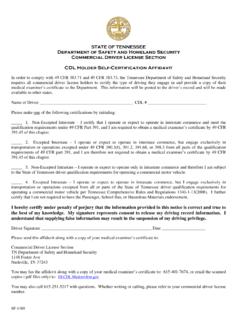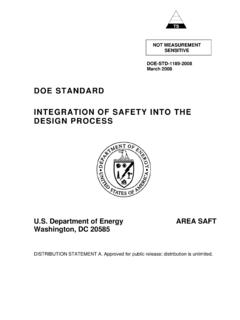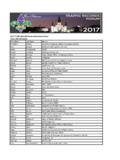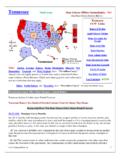Transcription of TENNESSEE DEPARTMENT OF AGRICULTURE …
1 TENNESSEE DEPARTMENT OF AGRICULTURE . regulatory services / FOOD & DAIRY. BOX 40627 MELROSE STATION. NASHVILLE, TN 37204. PHONE # 615-837-5193 FAX# 615-837-5005. HONEY HOUSE SANITATION GUIDELINES. A honey house is any building, or any room or place within a building, used for the purpose of extracting, processing and/or other handling of honey. 1. Floors: The floors of all rooms in which honey is handled, extracted, processed and packed, and the storage rooms for honey, shall be of concrete or other equally impervious and easily cleaned material, and shall be smooth, kept clean and in good repair, properly sloped and provided with trapped drains. Floors in facilities permitted after July1, 2008, shall be provided with trapped drains and be properly sloped to aid in cleaning and prevent pooling of water. 2. Walls and Ceilings: Walls and ceilings of rooms in which honey is processed or packed shall have smooth, washable, and durable surfaces of light-colored material, and shall be kept clean and in good repair.
2 3. Doors and Windows: All outer honey house doors shall be kept closed during the extraction, processing, preparing, packaging or handling of honey and shall be kept clean and in good repair. Windows which are open during the extraction, processing, preparing, packaging or handling of honey shall be effectively screened to prevent entrance of insects however may be provided with bee escapes and shall be kept clean and in good repair. 4. Lighting and Ventilation: All rooms shall be adequately ventilated, and there shall be sufficient light to permit efficient operations including cleaning of the equipment. Shielded or shatter-resistant lighting in the processing area shall be provided. 5. Extracting Equipment: Covers shall be on all extractors, except when in motion, and when being loaded or unloaded. All honey stored in tanks shall be covered so as to prevent any contamination from dust or rodents.
3 6. Water Supply: The water supply for the honey processing room shall be an adequate water supply derived from a municipal service or a private water supply deemed to be safe as determined by inspection for proper construction of wells or springs, backflow prevention measures and annual microbiological analysis for coliform conducted at a laboratory deemed acceptable by the TENNESSEE DEPARTMENT of AGRICULTURE . Current documentation of the laboratory analysis must be kept at the facility for review at the time of inspection. 1. 7. Waste Disposal: Waste shall be handled in such a manner as to not attract insects, rodents, birds, or other vermin; or create an environmental hazard. 8. Construction and Repair of Containers and Equipment: All multi-use utensils, containers and equipment which may come in contact with the honey shall be constructed of smooth, nonabsorbent, corrosion resistant, non-toxic materials safe for their intended use so as to be easily cleaned and shall be kept clean and in good repair.
4 Written verification relative to food safety from the manufacturer of the equipment, containers or utensils may be required. 9. Storage of Equipment: All extractors, tanks, and other equipment shall be stored in such a manner that they are properly protected from dust, dirt, rodents, insects or other contamination. 10. Cleaning of Equipment: Adequate facilities with hot and cold running water must be provided, including a sink separate from the hand-washing sink, for the cleaning and sanitization of all utensils and equipment as well as adequate space for the draining or air-drying of all utensils and equipment that are or may become food product contact surfaces. All utensils and equipment must be effectively cleaned after each extraction. Only food grade cleaners and sanitizers with manufacturer's directions for use may be used for the cleaning and sanitization of utensils and equipment that may come in contact with the honey.
5 Test strips or other acceptable means shall be utilized to ensure sanitizer strengths comply with manufacturer's directions of use. 11. Hand-Washing and Toilets: Adequate hand-washing facilities, separate from the utensil cleaning facilities, which include hot and cold water, single service paper towels and hand soap shall be provided for personnel. Toilet facilities, including wash basins, shall be conveniently available to honey house personnel. Toilet rooms shall not open directly into any room in which honey is handled or stored, shall be clean, in good repair, free of insects and rodents and have a fly tight self-closing door. Waste receptacle if provided shall be covered. 12. Personnel: Workers shall wear clean outer-clothing and adequate hair covering at all times during extracting, processing, and/or bottling, and shall keep hands clean at all times while thus engaged.
6 Workers shall refrain from eating and drinking, and shall not use tobacco products while handling, processing, and/or packaging honey. The use of loose or dangling jewelry, nail polish, and chewing gum is prohibited by persons in the honey house during processing, preparing, packaging, or handling of the honey. 13. Vehicle(s): That part of the vehicle(s) used to transport supers shall be clean. Supers shall be so loaded and lidded to protect them from rain, dust, and other contaminants while in transit. 14. Labeling: a. All food items packaged at the facility must be properly labeled prior to sale. The following, at a minimum, must be present on all food items: (1.) The name, street address, city, state and zip code of the manufacturer, packer, or distributor (2.) An accurate statement of the net amount of food in the package in ounces (oz.). and grams (gr.). 2. (3.)
7 The common or usual name of the food (4.) The ingredients in the food b. Lot dates or numbers are recommended on each package or container of food for traceability purposes in the event an issue occurs, which may require a market withdrawal of the food. A current distribution list including quantities sold may also be of assistance should an incident occur. 15. Chemical Pest Control Applications: There shall be no evidence of rodent activity or insects other than bees. Chemical pest control application shall be conducted in a manner consistent with manufacturer's directions so as to not contaminate food products or food product contact surfaces. A person shall not apply a pesticide within a building used for the preparation or the serving of food except under the direct supervision of a person licensed to apply pesticides in accordance with General Provision 62-21-124(a)(4), Chapter XXI (21) of the TENNESSEE Application of Pesticides Act of 1978.
8 16. Protection from Contamination: Operation of the facility shall be conducted in such a manner as to protect the honey from contamination during preparing, processing, packaging, storage and distribution. Where applicable, containers may require sanitization prior to use. Only food grade containers and closures may be used for packaging honey. Written verification relative to food safety from the manufacturer of the packaging materials, containers, or closures may be required. Suitable dispensing/measuring utensils, stored in a manner so as to preclude contamination, shall be used to avoid unnecessary manual contact with the food. During periods of extracting, processing and bottling, the equipment and the honey house shall be used for these purposes only.. 3.




